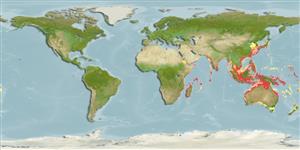Environment: milieu / climate zone / depth range / distribution range
Écologie
marin démersal; non migrateur; profondeur 7 - 85 m (Ref. 9790). Deep-water
Indo-West Pacific: widespread, from Sri Lanka and India north to southern Japan; south to the Philippines; South China Sea; Gulf of Thailand; Indonesia; Papua New Guinea; the Arafura Sea (Ref. 9819); Australia from Cockburn Sound, Western Australia to Moreton Bay, Queensland. A record from Reunion is based on a single specimen (MNHN 6846, holotype of Platycephalus borboniensis) that seems to be in error (Ref. 33528).
Taille / Poids / Âge
Maturity: Lm ? range ? - ? cm
Max length : 35.0 cm TL mâle / non sexé; (Ref. 48635); common length : 20.0 cm TL mâle / non sexé; (Ref. 9790)
Épines dorsales (Total): 9; Rayons mous dorsaux (Total): 11-13; Épines anales 0; Rayons mous anaux: 11 - 13. Preopercular spines usually 3, upper spine short, subequal with next; small accessory spine usually present. Suborbital ridge usually smooth except for two spines under eye. Interopercular flap present.
Found on sand and mud bottoms of the continental shelf.
Life cycle and mating behavior
Maturité | Reproduction | Frai | Œufs | Fécondité | Larves
Also Ref. 32209.
Knapp, L.W., 1984. Platycephalidae. In W. Fischer and G. Bianchi (eds.) FAO species identification sheets for fishery purposes. Western Indian Ocean (Fishing Area 51). Vol. 3. FAO, Rome. pag. var. (Ref. 3476)
Statut dans la liste rouge de l'IUCN (Ref. 130435)
Menace pour l'homme
Harmless
Utilisations par l'homme
Pêcheries: intérêt commercial mineur
Plus d'informations
RéférencesAquacultureProfil d'aquacultureSouchesGénétiqueElectrophoresesHéritabilitéPathologiesTraitementNutrientsMass conversion
CollaborateursImagesStamps, Coins Misc.SonsCiguateraVitesseType de nageSurface branchialeOtolithesCerveauxVision
Outils
Articles particuliers
Télécharger en XML
Sources Internet
Estimates based on models
Preferred temperature (Ref.
123201): 23.6 - 29, mean 27.9 °C (based on 1172 cells).
Phylogenetic diversity index (Ref.
82804): PD
50 = 0.6250 [Uniqueness, from 0.5 = low to 2.0 = high].
Bayesian length-weight: a=0.00575 (0.00329 - 0.01007), b=3.06 (2.90 - 3.22), in cm total length, based on LWR estimates for this species & (Sub)family-body (Ref.
93245).
Niveau trophique (Ref.
69278): 3.7 ±0.4 se; based on diet studies.
Résilience (Ref.
120179): Milieu, temps minimum de doublement de population : 1,4 à 4,4 années (Preliminary K or Fecundity.).
Fishing Vulnerability (Ref.
59153): Low vulnerability (25 of 100).
